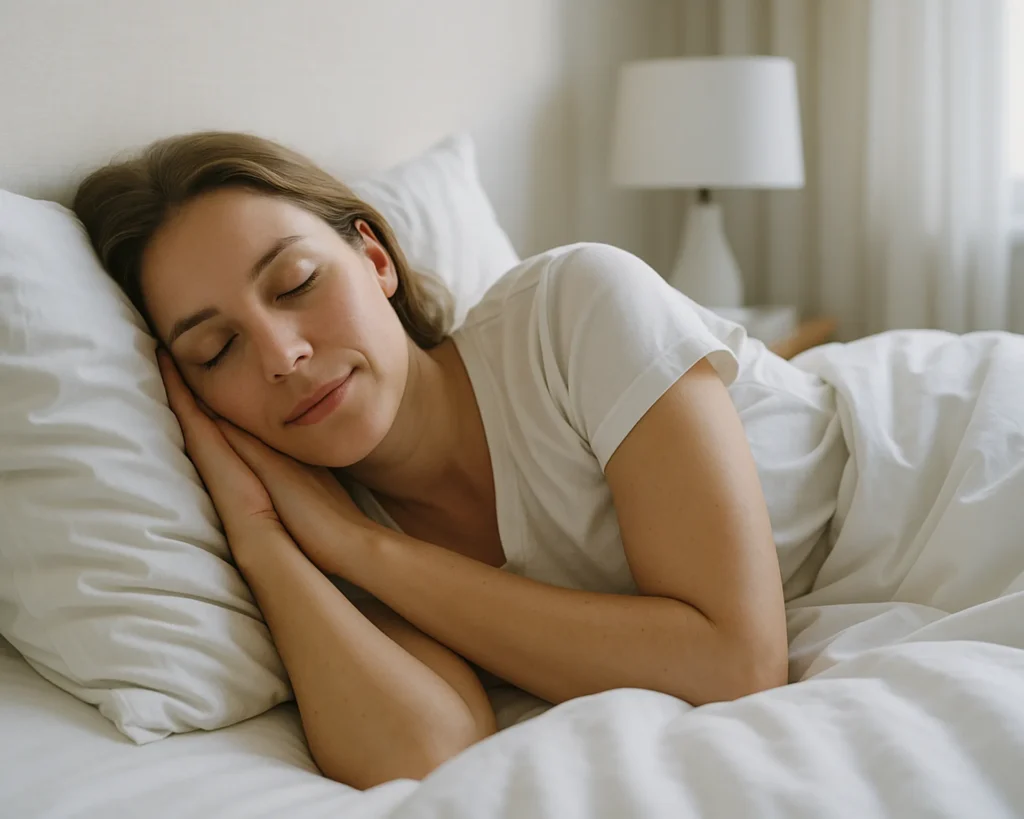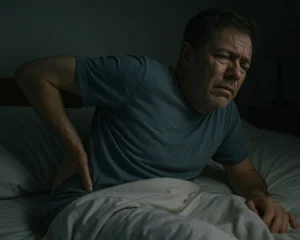If you’re living with chronic pain, you know how difficult it can be to get a good night’s sleep. Pain keeps you awake, tossing and turning, unable to find a comfortable position. But what many people don’t realize is that the relationship between sleep and pain works both ways — poor sleep doesn’t just result from chronic pain, it actually makes your pain worse. This creates a frustrating cycle that can feel impossible to break. The good news is that by improving your sleep quality, you can dramatically reduce your chronic pain levels. Research shows that better sleep can decrease pain intensity by 30-40%, making it one of the most powerful tools in your pain management toolkit.
Understanding the Bidirectional Sleep-Pain Relationship
The connection between sleep and chronic pain is what scientists call “bidirectional” — meaning each one affects the other in a continuous loop. When you experience chronic pain, it disrupts your ability to fall asleep and stay asleep throughout the night. You might wake up frequently due to discomfort, or find it impossible to get into deep, restorative sleep stages because pain keeps pulling you back to consciousness.
But here’s what makes this relationship particularly challenging: lack of sleep doesn’t just leave you tired — it actually lowers your pain threshold and increases your sensitivity to pain. When you’re sleep-deprived, your body produces more inflammatory chemicals and stress hormones like cortisol. These biological changes make you more sensitive to pain signals, meaning the same level of physical discomfort feels significantly worse when you haven’t slept well. Studies using brain imaging have shown that sleep deprivation amplifies pain-related brain activity, essentially turning up the volume on your body’s pain signals.
This creates a vicious cycle: pain disrupts sleep, poor sleep intensifies pain, which further disrupts sleep, and so on. Breaking this cycle requires addressing both sides of the equation — managing your pain to improve sleep, and improving sleep to reduce pain. According to the Sleep Foundation, chronic pain affects approximately 50-80% of people with sleep disorders, highlighting just how intertwined these two conditions are.
How Sleep Deprivation Amplifies Pain Perception
When you don’t get enough quality sleep, several physiological changes occur that directly impact how you experience pain. Your body’s natural pain-relieving systems become less effective, while inflammatory processes ramp up. Research published in the journal Sleep found that even a single night of poor sleep can increase pain sensitivity the following day. Over time, chronic sleep deprivation can lead to a condition called central sensitization, where your nervous system becomes hypersensitive to pain signals.
Additionally, lack of sleep affects your emotional regulation and stress response. When you’re exhausted, you have less mental and emotional resources to cope with pain, making it feel more overwhelming and unbearable. This psychological component is just as real as the physical changes, and it’s why addressing sleep is so crucial for comprehensive pain management.
The Science Behind Sleep and Pain Relief
Understanding why sleep is so important for pain management starts with understanding what happens during quality sleep. When you sleep well, your body goes through several critical restorative processes that directly impact pain levels. During deep sleep stages, your body releases growth hormone, which helps repair tissues and reduce inflammation. Your immune system also does much of its repair work during sleep, helping to heal injuries and calm inflammatory responses that contribute to chronic pain conditions.
Sleep also plays a crucial role in regulating neurotransmitters — the chemical messengers in your brain that influence pain perception. Adequate sleep helps maintain healthy levels of serotonin and dopamine, which are involved in your body’s natural pain-relief systems. When these neurotransmitters are balanced, your pain threshold increases, meaning you can tolerate discomfort better. The National Institutes of Health has conducted extensive research showing that sleep deprivation disrupts these pain-modulating pathways, making pain feel more intense.
Furthermore, quality sleep helps regulate your body’s stress response. When you’re well-rested, your cortisol levels (the primary stress hormone) follow a healthy pattern — higher in the morning to help you wake up, and lower at night to help you sleep. Chronic sleep deprivation disrupts this pattern, keeping cortisol elevated throughout the day and night. High cortisol levels increase inflammation and muscle tension, both of which worsen chronic pain conditions like fibromyalgia, arthritis, and back pain.
Practical Sleep Hygiene Strategies for Pain Management
Improving your sleep when you’re dealing with chronic pain requires a comprehensive approach that addresses both the physical environment and your daily habits. Sleep hygiene — the practices and habits that promote consistent, quality sleep — becomes even more important when pain is part of the equation. Here are evidence-based strategies that can help you break the pain-sleep cycle and get the restorative rest your body needs.
Optimize Your Sleep Environment
Your bedroom environment plays a crucial role in sleep quality, especially when you’re managing chronic pain. Start with temperature — research shows that the ideal sleeping temperature is between 60-67°F (15-19°C). A cooler room helps your body reach the lower core temperature needed for deep sleep, and it can also reduce inflammation that contributes to pain.
Invest in a supportive mattress and pillows that accommodate your specific pain condition. If you have back pain, you might need a medium-firm mattress with proper lumbar support. For neck pain, the right pillow height is critical — it should keep your spine aligned whether you sleep on your back or side. Consider using additional pillows to support painful areas: a pillow between your knees if you’re a side sleeper with hip or back pain, or under your knees if you sleep on your back.
Make your room as dark as possible using blackout curtains or an eye mask. Light exposure, even from small sources like alarm clocks or electronics, can disrupt your body’s production of melatonin, the hormone that regulates sleep. Similarly, minimize noise with earplugs, a white noise machine, or a fan. These environmental adjustments create optimal conditions for your body to achieve the deep, restorative sleep that’s essential for pain relief.
Establish a Consistent Sleep Schedule
One of the most powerful sleep hygiene practices is maintaining a consistent sleep-wake schedule, even on weekends. Going to bed and waking up at the same time every day helps regulate your body’s internal clock, making it easier to fall asleep and wake up naturally. This consistency is particularly important for chronic pain sufferers because it helps stabilize your body’s pain-regulating systems.
Create a relaxing bedtime routine that signals to your body it’s time to wind down. This might include gentle stretching, reading, taking a warm bath, or practicing relaxation techniques. Avoid stimulating activities like intense exercise, work tasks, or emotionally charged conversations in the hour before bed. The Mayo Clinic recommends establishing a routine that you follow every night, as this predictability helps your brain and body prepare for sleep.
Mind Your Evening Habits
What you do in the hours before bed significantly impacts your sleep quality. Limit caffeine intake after 2 PM, as it can stay in your system for 6-8 hours and interfere with falling asleep. Be cautious with alcohol as well — while it might make you feel sleepy initially, it disrupts sleep architecture and prevents you from reaching deep, restorative sleep stages.
Reduce screen time at least one hour before bed. The blue light emitted by phones, tablets, and computers suppresses melatonin production and keeps your brain alert. If you must use devices, enable blue light filters or wear blue-light-blocking glasses. Instead of scrolling through your phone, try reading a physical book, listening to calming music, or practicing gentle yoga or meditation.
Pay attention to your evening meals as well. Eating heavy, spicy, or acidic foods close to bedtime can cause discomfort and disrupt sleep. If you’re hungry before bed, opt for a light snack that combines protein and complex carbohydrates, like a small handful of nuts or whole-grain crackers with cheese.
Pain-Specific Sleep Positions and Techniques
Finding the right sleep position can make a significant difference in both pain levels and sleep quality. The optimal position depends on where you experience pain, but there are general principles that apply to most chronic pain conditions.
For back pain, sleeping on your back with a pillow under your knees helps maintain the natural curve of your spine and reduces pressure on your lower back. If you prefer side sleeping, place a pillow between your knees to keep your hips, pelvis, and spine aligned. Avoid sleeping on your stomach if possible, as this position can strain your neck and lower back.
If you have neck pain, ensure your pillow keeps your neck aligned with your spine — not too high or too low. Memory foam or cervical pillows designed to support the natural curve of your neck can be particularly helpful. For shoulder pain, avoid sleeping on the affected shoulder. Instead, sleep on your back or on the opposite side with a pillow hugging your chest to support your painful shoulder.
People with hip pain often find relief by sleeping on their back with a pillow under their knees, or on their non-painful side with a pillow between their knees. For arthritis pain that worsens at night, some people find that wearing compression gloves or using heating pads (set on low and used safely) before bed can reduce morning stiffness and improve sleep quality.
When to Seek Professional Help
While improving sleep hygiene can make a significant difference for many people with chronic pain, sometimes professional intervention is necessary. If you’ve tried implementing better sleep habits for several weeks and still struggle with sleep, it may be time to consult a healthcare provider. Certain sleep disorders, such as sleep apnea or restless leg syndrome, require medical treatment and can significantly worsen chronic pain if left untreated.
Similarly, if your pain is so severe that it prevents sleep despite your best efforts, you may need additional pain management strategies. This is where a comprehensive, non-invasive approach becomes invaluable. At Pain Defeat, our physical therapy services can help address the underlying causes of your pain, making it easier to sleep. Our therapists can teach you specific exercises and stretches that reduce pain and promote relaxation before bed.
Additionally, massage therapy has been shown to improve both pain and sleep quality by reducing muscle tension, lowering stress hormones, and promoting relaxation. Regular massage sessions can help break the pain-sleep cycle by addressing both the physical and stress-related components of chronic pain. Chiropractic care can also be beneficial, particularly for pain related to spinal misalignment or joint dysfunction that worsens at night.
If you suspect you have a sleep disorder in addition to chronic pain, ask your doctor about a sleep study. Conditions like sleep apnea, where breathing repeatedly stops and starts during sleep, are common in people with chronic pain and can make both conditions worse. Treating sleep apnea with CPAP therapy or other interventions can lead to dramatic improvements in both sleep quality and pain levels.
Breaking the Cycle: Your Path to Better Sleep and Less Pain
The relationship between sleep and chronic pain is complex, but understanding this connection empowers you to take action. By prioritizing sleep as a fundamental part of your pain management strategy, you’re not just addressing a symptom — you’re targeting one of the root causes that perpetuates chronic pain. Better sleep reduces inflammation, regulates pain-modulating neurotransmitters, lowers stress hormones, and gives your body the time it needs to heal and repair.
Start with small, manageable changes to your sleep environment and habits. Optimize your bedroom for sleep, establish a consistent schedule, and be mindful of your evening routines. Experiment with different sleep positions and supportive pillows to find what works best for your specific pain condition. Remember that improvement may be gradual — it can take several weeks for new sleep habits to show their full benefits, so be patient with yourself.
Most importantly, recognize that you don’t have to navigate this journey alone. Professional support can make all the difference in breaking the pain-sleep cycle. Whether through physical therapy to address the underlying causes of your pain, massage therapy to promote relaxation and reduce muscle tension, or chiropractic care to improve spinal alignment, a comprehensive approach gives you the best chance of achieving lasting relief.





